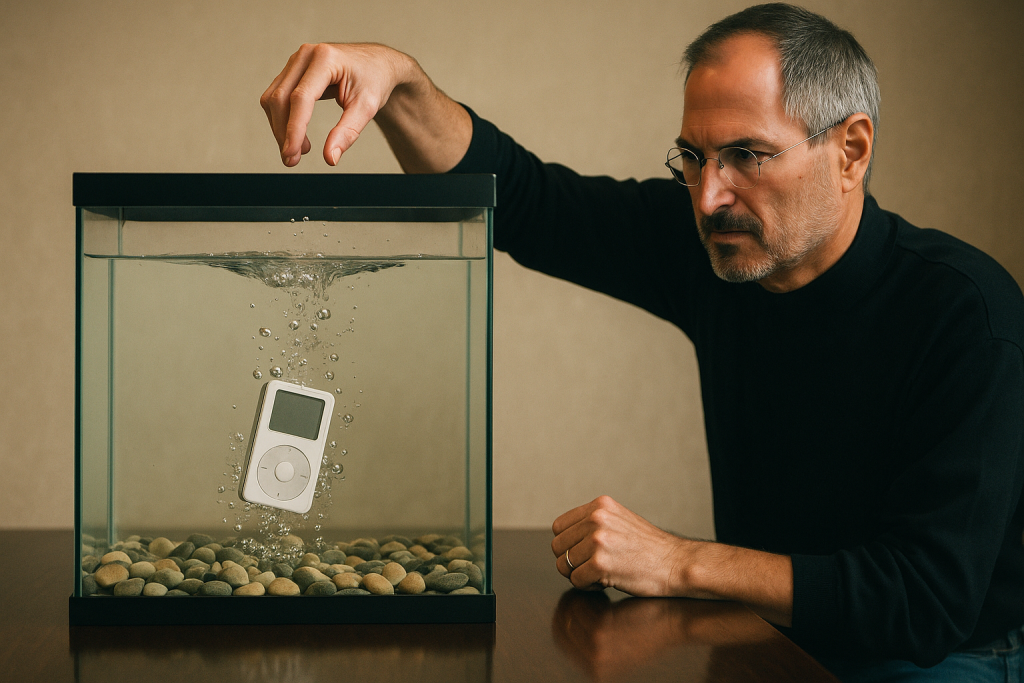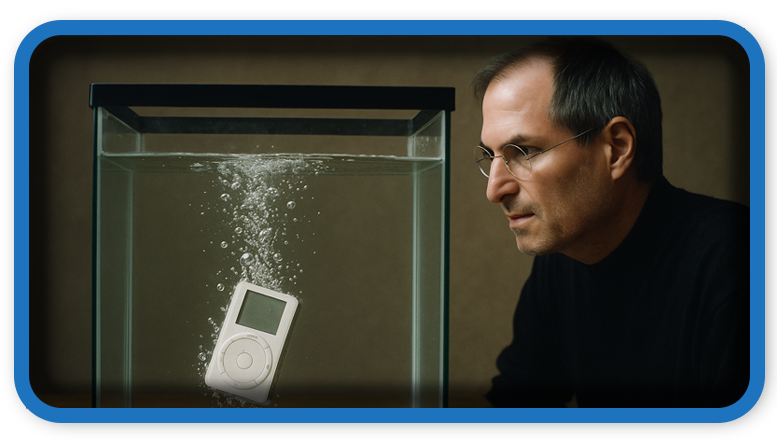⏲️ Estimated reading time: 5 min
WordPress Story of Steve Jobs and the iPod prototype…
When Steve Jobs was shown the first iPod prototype, he rejected the idea that it couldn’t be smaller. His response? Drop it in a fish tank. What happened next defined the Apple mindset and reshaped technology forever.
The Power of Perspective: Steve Jobs and the Fish Tank Moment
In the early 2000s, Apple was preparing to unveil what would become one of its most revolutionary products: the iPod. But behind the sleek design and seamless performance that consumers would come to love was a relentless vision one that refused to accept “impossible” as an answer.
One of the most iconic moments in Apple’s design history came during the development of the first iPod prototype. Engineers had spent months crafting a compact, functional music player and were proud of what they had created. They presented the device to Steve Jobs, expecting approval.
Instead, Jobs took the iPod, examined it, and calmly said, “It’s too big.”
The engineers pushed back. They explained that every millimeter of internal space was essential. There was no way to make it smaller.
Jobs said nothing.
He stood up, walked over to an aquarium, and dropped the prototype into the water. As it sank, air bubbles floated to the top.
“Those are air bubbles,” Jobs said. “That means there’s space in there. Make it smaller.”
This wasn’t just a clever gesture it was a declaration of principle. For Steve Jobs, innovation wasn’t about accepting constraints. It was about challenging them until something new emerged.

Thinking Beyond Limits
The aquarium story isn’t just a tale about a gadget. It’s a case study in mindset one that dares to question the status quo. While most people see limits as barriers, innovators like Jobs see them as puzzles waiting to be solved.
The phrase “make it smaller” didn’t only apply to physical dimensions. It meant refining the design, simplifying the user interface, eliminating unnecessary components, and enhancing efficiency.
This mindset is responsible for many of Apple’s triumphs:
- The razor-thin MacBook Air
- The intuitive design of the iPhone
- The removal of headphone jacks in favor of wireless AirPods
Each of these decisions faced initial resistance. But Apple’s ability to ask “what if?” rather than accept “what is” continually pushed them into new territory.
The Importance of Asking Better Questions
What truly set Jobs apart wasn’t his technical expertise it was his curiosity and demand for excellence.
Instead of asking, “Can we do this?” he asked, “How can we do this better?”
This shift in questioning is critical for innovators, creators, and entrepreneurs. It forces people to reframe problems and discover solutions that weren’t initially obvious. The air bubbles in the tank weren’t just proof of physical space they symbolized unchallenged assumptions.
Jobs often said that design isn’t just how something looks, but how it works. The fish tank moment was about function. It was about optimizing every inch of a device for the best user experience.
A Lesson for Creators and Innovators
This story has become legend in tech circles, but its message applies far beyond Silicon Valley.
Whether you’re building software, writing a book, managing a business, or designing a home there will always be someone who says, “It can’t be done.” Often, that voice is in your own head.
Steve Jobs showed us that instead of accepting that response, we should question it.
- Are we operating based on facts or assumptions?
- Are we constrained by fear or by physics?
- Have we explored all options or just the obvious ones?
By asking better questions, we often find better answers.
Cultivating the “Fish Tank” Mindset
You don’t have to be Steve Jobs to think like him. The aquarium anecdote is a practical metaphor for how to approach any creative challenge. Here’s how you can apply the same principles:
1. Challenge Every Assumption
Start with the idea that no rule is sacred. Just because something has always been done a certain way doesn’t mean it’s the best way.
2. Use Visual Demonstrations
Jobs dropping the iPod into a tank wasn’t for show it made a point that words couldn’t. In your own work, find ways to make abstract issues visible and visceral.
3. Seek Elegance in Simplicity
Jobs believed simplicity was the ultimate sophistication. Whether you’re writing code, creating art, or managing a project, reduce complexity wherever possible.
4. Never Settle
If the response to a challenge is “this is the best we can do,” don’t stop. Ask, “What would the best really look like?”
5. Focus on the User Experience
Everything Jobs did centered around the user. Make every decision from design to delivery through the lens of the people you’re trying to serve.
The iPod’s Legacy
When the iPod launched in 2001, it wasn’t the first MP3 player. But it was the best sleek, user-friendly, and elegant in design. It didn’t just play music; it changed the way people experienced it.
Apple’s music player went on to dominate the industry and laid the foundation for the iPhone, which would transform not just communication, but culture.
All of that sprang from a simple refusal to accept “it can’t be done.”
Final Thoughts
The story of Steve Jobs, the iPod, and the aquarium is more than a tech anecdote. It’s a philosophy.
In a world full of limits, the most powerful thing we can do is ask better questions.
So the next time you’re told something can’t be done look for the air bubbles.
📩 Do you have questions or suggestions? Leave a comment or contact us!
🏷️ Tags: Steve Jobs, iPod, innovation mindset, Apple history, design thinking, product development, user experience, tech leadership, entrepreneur inspiration, technology legends
📢 Hashtags: #SteveJobs #iPodStory #AppleInnovation #ThinkDifferent #TechLeadership #DesignThinking #Invention #EntrepreneurMindset #UserExperience #ImpossibleIsNothing
Only logged-in users can submit reports.
Discover more from HelpZone
Subscribe to get the latest posts sent to your email.

